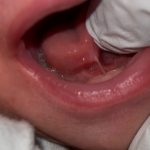My baby is only a few days old, is it too early for a Tongue Tie Division?
No, the sooner the Tongue Tie gets revised, the better. As soon as there are feeding difficulties it is advisable to do a full assessment of latch and attachment, tongue and motility. If there is a Tongue Tie present it should be divided

My baby has no feeding difficulties should we go ahead with the procedure?
After a thorough assessment of the feeding situation and the mouth/tongue and there are really no feeding issues it is really up to the parents to decide. There is no conclusive data on how many children with Tongue Tie will end up having problems with weaning the baby, orthodontic issues (such as overcrowding) and speech and language problems (such as unclear speech or a lisp). According to the NICE guidelines only babies should be treated that experience problems with breastfeeding, but I am able to go ahead with the procedure, should this be the parents wish.
Will the procedure hurt the baby
The procedure is usually well tolerated, babies usually cry for a few seconds and will usually settle within minutes. Baby will be fed straight after the procedure, ideally from the breast. I will help with latching and positioning of the baby. It is rare that babies are not able to feed after the procedure, very occasionally it might take a few days for baby to readjust to the new tongue mobility.
What do I need to bring to the appointment?
Please bring your red book, a big clean muslin/swaddling blanket and if baby has top ups or feeds from the bottle please bring baby’s feed. Please also bring nipple shields, should baby be using them. You might also bring a change of clothes for baby. You might want to bring your partner, family member or friend to the appointment.
Will my baby be unsetted after the procedure?
In my experience the younger the baby the better they tolerate the procedure. Overall all babies I have seen have had a quick recovery. Occasionally they are a little unsettled during the first night after the procedure. Very rarely we see babies guarding their tongue for the first few days and some babies experience muscle fatigue, which can occasionally make feeding a little difficult temporarily.
My baby will have his/her jabs around the same time
Ideally we would leave a space of 2/3 days between the procedure and the jabs.
Can you perform a Tongue Tie release shortly before or after a circumcision?
No, the sooner a Tongue Tie is treated, the better. The procedure is very small and is usually very well tolerated, the younger the baby, the easier it is. The wound heals very quickly and the baby is possibly a little unsettled for one day. Sometimes the Tongue Tie has to be released around the time of the Circumcision and there are no extra risks by doing so.
Low-Level Laser Therapy (LLLT) Treatment FAQ's
Q1: What is Low-Level Laser Therapy (LLLT)?
A: Low-Level Laser Therapy, also known as LLLT, is a non-invasive treatment that uses gentle laser light to stimulate tissue healing and reduce inflammation.
Q2: How does LLLT work for nipple damage?
A: LLLT promotes cellular activity and blood circulation, which can accelerate the healing process of damaged nipple tissues, reduce pain, and improve overall comfort.
Q3: Is LLLT safe?
A: Yes, LLLT is considered safe when administered by trained healthcare professionals. It is painless, non-invasive, and has minimal to no side effects.
Q4: How many sessions of LLLT are typically needed?
A: The number of sessions varies based on individual needs. During your consultation, we will assess your condition and recommend a personalised treatment plan.
Q5: Can LLLT be used alongside other treatments?
A: LLLT can complement other treatments and therapies. We will work with you to create a comprehensive approach tailored to your needs.
Therapeutic Ultrasound Treatment for Mastitis FAQ's
For Therapeutic Ultrasound Treatment:
Q1: What is therapeutic ultrasound?
A: Therapeutic ultrasound is a treatment that uses high-frequency sound waves to promote tissue healing, reduce inflammation, and alleviate discomfort.
Q2: How does therapeutic ultrasound work for mastitis?
A: Therapeutic ultrasound increases blood flow and can enhance the absorption of antibiotics in inflamed breast tissue, helping to soothe mastitis symptoms.
Q3: Is therapeutic ultrasound painful?
A: No, therapeutic ultrasound is generally painless. Clients often experience a warm and soothing sensation during the treatment.
Q4: Are there any side effects associated with therapeutic ultrasound?
A: Therapeutic ultrasound is considered safe with minimal side effects. It’s important to have the treatment administered by a qualified healthcare professional.
Q5: How soon can I expect to see results from therapeutic ultrasound?
A: Results may vary, but many clients experience relief from mastitis symptoms after a few sessions. Your response to treatment will be discussed during your consultation.
General FAQ's for Laser and Unltrasound therapies
Q1: Who should consider these treatments?
A: These treatments are suitable for breastfeeding mothers experiencing nipple damage or mastitis discomfort. Consult with our medical expert to determine if they’re right for you.
Q2: How do I schedule a consultation?
A: Contact us via [contact information] to schedule a consultation. We’ll assess your needs and provide recommendations based on your unique situation.
Q3: Are these treatments covered by insurance?
A: Coverage varies. We recommend checking with your insurance provider to determine if these treatments are eligible for reimbursement.
Q4: What makes your clinic qualified to provide these treatments?
A: Our clinic is led by a qualified doctor and International Board Certified Lactation Consultant. We offer evidence-based treatments and personalised care to support your well-being.
Q5: Is there anything I need to do before the treatment?
A: Before your treatment, we will provide you with any necessary instructions. Generally, no special preparation is needed for these non-invasive treatments.




